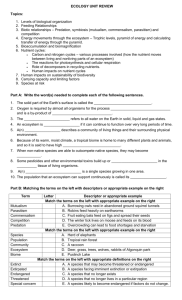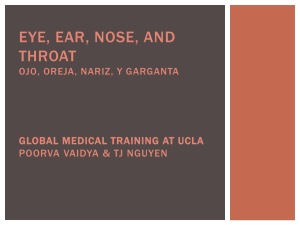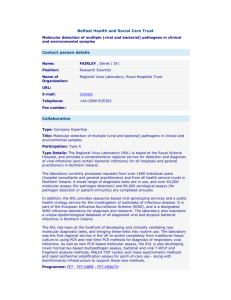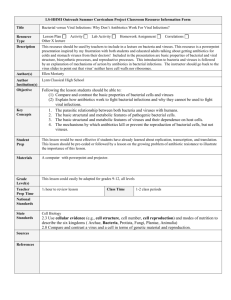Diseases
advertisement
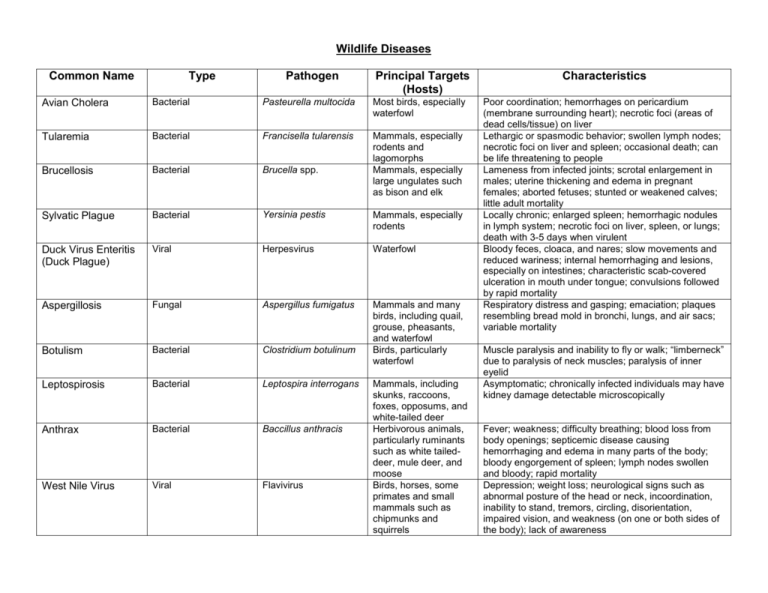
Wildlife Diseases Common Name Type Pathogen Principal Targets (Hosts) Avian Cholera Bacterial Pasteurella multocida Most birds, especially waterfowl Tularemia Bacterial Francisella tularensis Brucellosis Bacterial Brucella spp. Mammals, especially rodents and lagomorphs Mammals, especially large ungulates such as bison and elk Sylvatic Plague Bacterial Yersinia pestis Mammals, especially rodents Duck Virus Enteritis (Duck Plague) Viral Herpesvirus Waterfowl Aspergillosis Fungal Aspergillus fumigatus Botulism Bacterial Clostridium botulinum Mammals and many birds, including quail, grouse, pheasants, and waterfowl Birds, particularly waterfowl Leptospirosis Bacterial Leptospira interrogans Anthrax Bacterial Baccillus anthracis West Nile Virus Viral Flavivirus Mammals, including skunks, raccoons, foxes, opposums, and white-tailed deer Herbivorous animals, particularly ruminants such as white taileddeer, mule deer, and moose Birds, horses, some primates and small mammals such as chipmunks and squirrels Characteristics Poor coordination; hemorrhages on pericardium (membrane surrounding heart); necrotic foci (areas of dead cells/tissue) on liver Lethargic or spasmodic behavior; swollen lymph nodes; necrotic foci on liver and spleen; occasional death; can be life threatening to people Lameness from infected joints; scrotal enlargement in males; uterine thickening and edema in pregnant females; aborted fetuses; stunted or weakened calves; little adult mortality Locally chronic; enlarged spleen; hemorrhagic nodules in lymph system; necrotic foci on liver, spleen, or lungs; death with 3-5 days when virulent Bloody feces, cloaca, and nares; slow movements and reduced wariness; internal hemorrhaging and lesions, especially on intestines; characteristic scab-covered ulceration in mouth under tongue; convulsions followed by rapid mortality Respiratory distress and gasping; emaciation; plaques resembling bread mold in bronchi, lungs, and air sacs; variable mortality Muscle paralysis and inability to fly or walk; “limberneck” due to paralysis of neck muscles; paralysis of inner eyelid Asymptomatic; chronically infected individuals may have kidney damage detectable microscopically Fever; weakness; difficulty breathing; blood loss from body openings; septicemic disease causing hemorrhaging and edema in many parts of the body; bloody engorgement of spleen; lymph nodes swollen and bloody; rapid mortality Depression; weight loss; neurological signs such as abnormal posture of the head or neck, incoordination, inability to stand, tremors, circling, disorientation, impaired vision, and weakness (on one or both sides of the body); lack of awareness Common Name Type Pathogen Principal Targets (Hosts) Lyme Disease Bacterial Borrelia burgdorferi White-tailed deer, reptiles, rodents Rabies Viral Rhabdovirus Mammals, particularly carnivores and omnivores such as skunks, raccoons, foxes, and bats Distemper Viral Paramyxovirus Carnivores and omnivores such as wolves, coyotes, foxes, bobcats, raccoons, and skunks Avian Pox Viral Pox Birds Salmonella Bacterial Salmonella spp. Birds Tuberculosis Bacterial Mycobacterium bovis Ungulates such as white-tailed deer and elk Hemorrhagic Disease Viral Epizootic heamorrhagic or bluetongue viruses Ruminants such as white-tailed deer, mule deer, black-tailed deer, bighorn sheep, and pronghorn antelope. Chronic Wasting Disease Transmissible spongiform encephalopathy Thought to be associated with a prion (self-replicating protein) Deer, elk, and moose Characteristics Few signs or effects in wildlife; Painful joints and lameness; fever; behavioral changes; neurological problems, and possible death if not treated in humans. Two forms, “dumb” rabies and “furious” rabies; “dumb” rabies characterized by aimless wandering, lethargy, incoordination, weakness in hind legs, and loss of awareness; “furious” rabies characterized by vicious attacks and self-mutilations; both forms result in convulsions, coma, and death Respiratory and intestinal problems such as coughing, diarrhea, vomiting, nasal and ocular discharge, anorexia; abnormal behavior and apparent lack of fear; neurological disturbances such as aggressiveness, disorientation, lack of alertness, convulsive movements of the head and feet, and aimless wandering; dehydration and excessive thirst; enlarged spleen Vision problems; respiratory distress; emaciation or weakness; lesions on unfeathered areas of the head and legs, oral cavity, and upper respiratory tract Ruffled feathers; droopiness; diarrhea; severe lethargy; emaciation; seizures and convulsions; swollen liver, plaques on liver and in body cavity; swollen nodules sometimes present in esophagus Emaciation: depression: Intolerance of movement and debilitation; coughing, nasal discharges, and difficulty breathing; development of large abscesses in the lymph nodes of the neck; necrotic foci and/or pus-filled nodules associated with the lymph nodes of the head and neck or the lungs Depression; fever; respiratory distress; lameness; emaciation; edema and swelling of head, neck, tongue, conjunctiva, and lungs; hemorrhages or congestion in heart, rumen, and intestines; necrosis or ulceration on dental pad, tongue, palate, rumen, omasum; growth interruptions and sloughing of hoof walls; death. Progressive weight loss; changes in temperament including loss of fear of humans, nervousness, and hyperactivity; changes in behavior such as teeth grinding and walking in repetitive patterns; incoordination; excessive thirst and urination; dehydration; drooping of the head and ears; excessive salivation; brain lesions and death.
